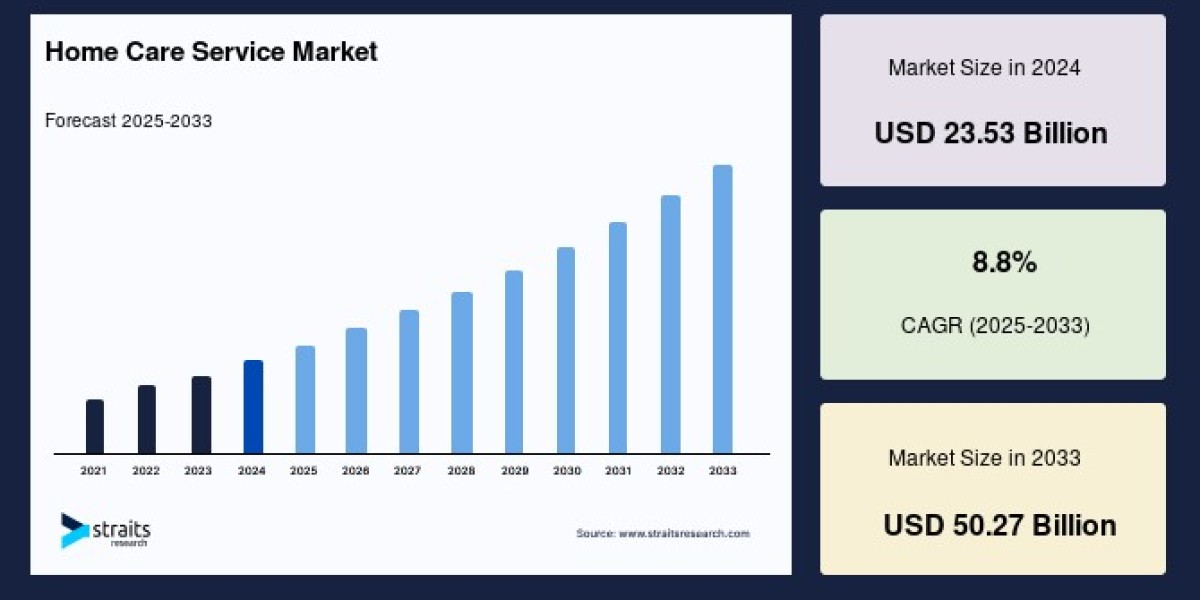The global home care service market size was valued at USD 23.53 billion in 2024 and is projected to reach from USD 25.60 billion in 2025 to USD 50.27 billion by 2033, growing at a CAGR of 8.8 % during the forecast period (2025-2033).
Market Overview and Service Segments
Home care services encompass broad offerings aimed at assisting individuals with daily tasks within their living or working environments. Services include laundry, errands, medication management, general cleaning, cooking, and medical care. These are further categorized into residential cleaning, personal care, private duty nursing, and more occasional home health care services.
Residential cleaning ranges from carpet and window cleaning to more specialized services like upholstery care. The commercial cleaning sector includes firms dedicated to carpet and window cleaning for business settings. The multifaceted nature of home care services supports a growing consumer base looking for convenience, hygiene, and professional caregiving assistance.
Drivers of Market Growth
One of the primary growth drivers is the rising elderly population worldwide, which demands more in-home care solutions to maintain independence and quality of life. The demographic trend towards an aging population, combined with a surge in chronic health conditions, necessitates services that allow elderly individuals to remain comfortably in their own homes, reducing the need for institutional care.
Urbanization and economic growth in emerging markets such as China, India, and Brazil contribute significantly to market expansion. Increased disposable incomes enable consumers in these regions to spend more on upscale home care services. Concurrently, in developed regions like the United States, Canada, and Germany, there is strong adoption driven by dual-income households seeking external assistance for home management.
Additionally, increased awareness of health, cleanliness, and sustainable green home care practices fuels demand globally. Advances in healthcare technology also enable complex medical care to be delivered in-home, attracting a larger demographic including patients requiring ongoing health monitoring and rehabilitation.
Regional Market Insights
The Asia-Pacific region commands the largest share of the home care service market, propelled by rapid urbanization, an expanding middle class, greater disposable incomes, and a rising elderly populace. Public awareness about health and cleanliness is significantly growing, and improving living standards within this region further drive market demand.
North America stands as the fastest-growing regional market, projected to reach USD 8.73 billion by 2030 with a CAGR of around 5.45%. The high prevalence of dual-income households, widespread usage of home care services, and a strong culture of outsourcing household tasks contribute to North America’s leading market position. Additionally, increasing numbers of women in the workforce and evolving lifestyle choices have heightened demand for services such as maid services, which account for a significant portion of the market.
Europe reflects a mature market with strong competition, where companies often leverage digital health solutions and advanced service delivery models. While smaller and medium businesses actively compete regionally, major corporations dominate through extensive networks and service innovations.
Market Challenges
Despite the growth opportunities, the home care service market faces challenges including limited availability of local service providers and manpower shortages in many regions. Insurance coverage for home care remains limited, which can restrict affordability and access, especially for more specialized medical services.
Moreover, market fragmentation, particularly in competitive regions, can impede growth for smaller players. Consumer preferences, regulatory environments, and economic disparities between urban and rural populations also influence market dynamics.
Future Outlook
The market’s outlook remains positive owing to increasing urbanization—predicted to grow from 54% urban population globally in 2014 to an estimated 68% by 2050—which stimulates demand for convenient home care solutions. The rise of smart home healthcare technologies and digital tools facilitates expanded access and improved quality of home care.
Household trends such as the rise in dual-income families and increasing female workforce participation are expected to sustain high demand for diverse home services including daily housekeeping, cooking, and medical care.
Furthermore, innovations aimed at eco-friendly and sustainable home care practices are gaining traction, responding to consumer environmental consciousness. The aging population's need for in-home assistance combined with improved economic conditions globally will continue to drive consistent market growth through the next decade, making home care services an essential and expanding sector worldwide.













